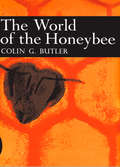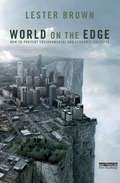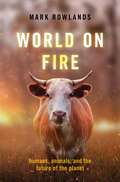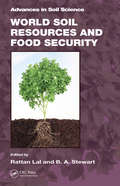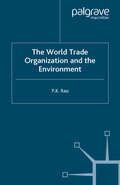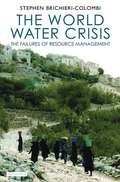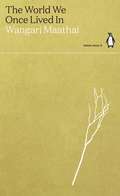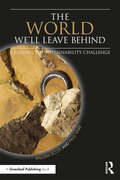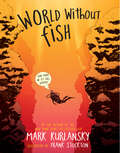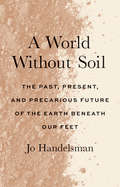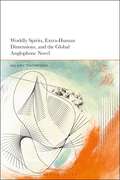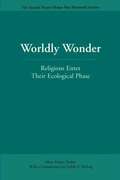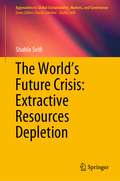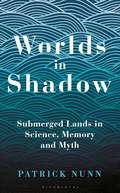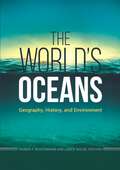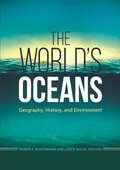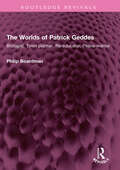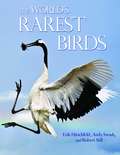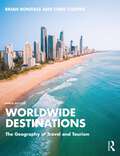- Table View
- List View
The World of the Honeybee (Collins New Naturalist Library #29)
by Colin G. ButlerThe mysteries of bee life are illuminated for beekeepers, entomologists and students of natural history in general.
World On The Edge: How to Prevent Environmental and Economic Collapse
by Lester BrownIn this urgent time, World on the Edge calls out the pivotal environmental issues and how to solve them now. We are in a race between political and natural tipping points. Can we close coal-fired power plants fast enough to save the Greenland ice sheet and avoid catastrophic sea level rise? Can we raise water productivity fast enough to halt the depletion of aquifers and avoid water-driven food shortages? Can we cope with peak water and peak oil at the same time? These are some of the issues Lester R. Brown skilfully distils in World on the Edge. Bringing decades of research and analysis into play, he provides the responses needed to reclaim our future.
World On The Edge: How to Prevent Environmental and Economic Collapse (PDF)
by Lester BrownIn this urgent time, World on the Edge calls out the pivotal environmental issues and how to solve them now. We are in a race between political and natural tipping points. Can we close coal-fired power plants fast enough to save the Greenland ice sheet and avoid catastrophic sea level rise? Can we raise water productivity fast enough to halt the depletion of aquifers and avoid water-driven food shortages? Can we cope with peak water and peak oil at the same time? These are some of the issues Lester R. Brown skilfully distils in World on the Edge. Bringing decades of research and analysis into play, he provides the responses needed to reclaim our future.
World on Fire: Humans, Animals, and the Future of the Planet
by Mark RowlandsMark Rowlands presents a novel analysis of three epoch-defining environmental problems: climate, extinction, and pestilence. Our climate is changing at a rate that is unprecedented and, if unchecked, disastrous. Species are disappearing hundreds or thousands of times faster than normal. COVID-19 has wreaked social and economic havoc but is merely the latest off a blossoming production line of emerging infectious diseases, many of which have the potential to be far worse. Rowlands establishes that all three problems are consequences of choices we have made about energy, which can be divided into two major forms: fuel and food. Focusing on food choices as far more central to the issue than commonly recognized, he argues that the solution is breaking our collective habit of eating animals. Rowlands shows that in doing so, we stem our insatiable hunger for land, which he identifies as central to the problems of extinction and pestilence. He explains that reversing the industrial farming of animals for food will first, substantially cut climate emissions, rapidly enough to allow sustainable energy technologies time to become viable alternatives; and most importantly, make vast areas of a land available for the kind of aggressive afforestation policy that he shows as necessary to bring all three problems under control. With World on Fire, Mark Rowlands identifies the source of our environmental ills and provides a compelling and accessible account of how to solve them.
World on Fire: Humans, Animals, and the Future of the Planet
by Mark RowlandsMark Rowlands presents a novel analysis of three epoch-defining environmental problems: climate, extinction, and pestilence. Our climate is changing at a rate that is unprecedented and, if unchecked, disastrous. Species are disappearing hundreds or thousands of times faster than normal. COVID-19 has wreaked social and economic havoc but is merely the latest off a blossoming production line of emerging infectious diseases, many of which have the potential to be far worse. Rowlands establishes that all three problems are consequences of choices we have made about energy, which can be divided into two major forms: fuel and food. Focusing on food choices as far more central to the issue than commonly recognized, he argues that the solution is breaking our collective habit of eating animals. Rowlands shows that in doing so, we stem our insatiable hunger for land, which he identifies as central to the problems of extinction and pestilence. He explains that reversing the industrial farming of animals for food will first, substantially cut climate emissions, rapidly enough to allow sustainable energy technologies time to become viable alternatives; and most importantly, make vast areas of a land available for the kind of aggressive afforestation policy that he shows as necessary to bring all three problems under control. With World on Fire, Mark Rowlands identifies the source of our environmental ills and provides a compelling and accessible account of how to solve them.
World Soil Resources and Food Security
by Rattan Lal B. A. StewartSoil-The Basis of All Terrestrial LifeAncient civilizations and cultures-Mayan, Aztec, Mesopotamian, Indus, and Yangtze-were built on good soils, surviving only as long as soils had the capacity to support them. In the twenty-first century, productive soil is still the engine of economic development and essential to human well-being. The quality of
The World Trade Organization and the Environment
by P. RaoThis book explains the role and limitations of liberalized international trade on the global environment and sustainable development. A distinguishing feature of this book is an integration of trade, environment and development perspectives for operationally meaningful policy purposes. The topics explored include an analysis of the global trade regimes, their interrelationships with the existing multilateral environmental agreements, institutional mechanisms governed by the World Trade Organization, and a framework for pragmatic reforms.
The World Water Crisis: The Failures of Resource Management (International Library of Human Geography)
by Stephen Brichieri-ColombiEarth - the blue planet - is a world more than half covered by oceans, its poles capped with ice sheets and its atmosphere laden with moisture. Yet, in the last decade, water resources planners have frequently signalled an impending water crisis. The message is that the world is running out of water and that only by careful planning and the adoption of integrated water resources management can catastrophe be avoided. In his impressive new work, Stephen Brichieri-Colombi challenges these perceptions over global freshwater availability. He maintains that the crisis is one of resource management rather than availability: it arises because water resource planners advocate exploitation of rivers without due regard to social, environmental and geopolitical consequences. Without an overarching political framework integrated water resource management fails on international rivers, its holy grail of optimality is illusory, and the benefits of basinwide co-operation over bilateral co-operation are minimal. The author advances a new paradigm - water in the national economy - which focuses upon improved domestic water management and the benefits from regional rather than basinwide co-operation. The approach combines insights from a wide range of disciplines and reveals how policies that favour family planning, urbanisation, improved diets, rain-fed farming, economic growth, food imports for cities and improved water-use efficiency can enable developing countries to meet future food and water demands without increasing abstraction from rivers and consequential riparian conflict. Combining technical expertise with a wealth of experience, The World Water Crisis: the Failures of Resource Management offers a lucid and powerful re-appraisal of the development of global water resources. It will command the interest of professionals, policy makers, researchers and academics involved in the practicalities and politics of global water issues.
The World We Once Lived In (Green Ideas)
by Wangari MaathaiIn twenty short books, Penguin brings you the classics of the environmental movement.From the Congo Basin to the traditions of the Kikuyu people, the lucid, incisive writings in The World We Once Lived In explore the sacred power of trees, and why humans lay waste to the forests that keep us alive.Over the past 75 years, a new canon has emerged. As life on Earth has become irrevocably altered by humans, visionary thinkers around the world have raised their voices to defend the planet, and affirm our place at the heart of its restoration. Their words have endured through the decades, becoming the classics of a movement. Together, these books show the richness of environmental thought, and point the way to a fairer, saner, greener world.
The World We'll Leave Behind: Grasping the Sustainability Challenge
by William Scott Paul VareIt is now clear that human activity has influenced how the biosphere supports life on Earth, and given rise to a set of connected environmental and social problems. In response to the challenge that these problems present, a series of international conferences and summits led to discussions of sustainable development and the core dilemma of our time: How can we all live well, now and in the future, without compromising the ability of the planet to enable us all to live well? This book identifies the main issues and challenges we now face; it explains the ideas that underpin them and their interconnection, and discusses a range of strategies through which they might be addressed and possibly resolved. These cover things that governments might do, what businesses and large organisations can contribute, and the scope for individuals, families and communities to get involved. This book is for everyone who cares about such challenges, and wants to know more about them.
The World We'll Leave Behind: Grasping the Sustainability Challenge
by William Scott Paul VareIt is now clear that human activity has influenced how the biosphere supports life on Earth, and given rise to a set of connected environmental and social problems. In response to the challenge that these problems present, a series of international conferences and summits led to discussions of sustainable development and the core dilemma of our time: How can we all live well, now and in the future, without compromising the ability of the planet to enable us all to live well? This book identifies the main issues and challenges we now face; it explains the ideas that underpin them and their interconnection, and discusses a range of strategies through which they might be addressed and possibly resolved. These cover things that governments might do, what businesses and large organisations can contribute, and the scope for individuals, families and communities to get involved. This book is for everyone who cares about such challenges, and wants to know more about them.
World Without Fish
by Mark KurlanskyA KID&’S GUIDE TO THE OCEAN "Can you imagine a world without fish? It's not as crazy as it sounds. But if we keep doing things the way we've been doing things, fish could become extinct within fifty years. So let's change the way we do things!"World Without Fish is the uniquely illustrated narrative nonfiction account—for kids—of what is happening to the world&’s oceans and what they can do about it. Written by Mark Kurlansky, author of Cod, Salt, The Big Oyster, and many other books, World Without Fish has been praised as &“urgent&” (Publishers Weekly) and &“a wonderfully fast-paced and engaging primer on the key questions surrounding fish and the sea&” (Paul Greenberg, author of Four Fish). It has also been included in the New York State Expeditionary Learning English Language Arts Curriculum. Written by a master storyteller, World Without Fish connects all the dots—biology, economics, evolution, politics, climate, history, culture, food, and nutrition—in a way that kids can really understand. It describes how the fish we most commonly eat, including tuna, salmon, cod, swordfish—even anchovies— could disappear within fifty years, and the domino effect it would have: the oceans teeming with jellyfish and turning pinkish orange from algal blooms, the seabirds disappearing, then reptiles, then mammals. It describes the back-and-forth dynamic of fishermen, who are the original environmentalists, and scientists, who not that long ago considered fish an endless resource. It explains why fish farming is not the answer—and why sustainable fishing is, and how to help return the oceans to their natural ecological balance. Interwoven with the book is a twelve-page graphic novel. Each beautifully illustrated chapter opener links to the next to form a larger fictional story that perfectly complements the text.
A World Without Soil: The Past, Present, and Precarious Future of the Earth Beneath Our Feet
by Jo HandelsmanA scientist’s manifesto addressing a soil loss crisis accelerated by poor conservation practices and climate change This book by celebrated biologist Jo Handelsman lays bare the complex connections among climate change, soil erosion, food and water security, and drug discovery. Humans depend on soil for 95 percent of global food production, yet let it erode at unsustainable rates. In the United States, China, and India, vast tracts of farmland will be barren of topsoil within this century. The combination of intensifying erosion caused by climate change and the increasing food needs of a growing world population is creating a desperate need for solutions to this crisis. Writing for a nonspecialist audience, Jo Handelsman celebrates the capacities of soil and explores the soil-related challenges of the near future. She begins by telling soil’s origin story, explains how it erodes and the subsequent repercussions worldwide, and offers solutions. She considers lessons learned from indigenous people who have sustainably farmed the same land for thousands of years, practices developed for large-scale agriculture, and proposals using technology and policy initiatives.
Worldly Spirits, Extra-Human Dimensions, and the Global Anglophone Novel
by Dr Hilary ThompsonEngaging a diverse range of contemporary anglophone literature from authors of the Asian, Middle Eastern and Caribbean diasporas, this book explores how such works turn to spirit forces, spirit realms and spirit beings - were-animals, mystical birds, and snake goddesses - as positive forces that assert perceptual dimensions beyond those of the human, and present a vision of Earth as agentive and animate. With previous scholarship downplaying these aspects of modern works as uncanny hauntings or symptoms of capitalism's or anthropocentrism's destructiveness, or within a blanket rubric of 'magical realism', Hilary Thompson rejects this partitioning of them as products of an exotic East or global South. By contrast, this book builds a new critical framework for analysis of worldly spirits, drawing on anthropological discussions of animism, the newly recovered 1930s boundary-crossing art movement Dimensionism, and multispecies theories of animals' diverse perceptual worlds. Taking stock of novels published from 2018-2020 by such writers as Amitav Ghosh, André Alexis, Yangsze Choo, Azareen Van der Vliet Oloomi, Zeyn Joukhadar, and Tanya Tagaq, Thompson illuminates how these works extend an ecological call to decentre the human and align with multidimensional theories of art and literature to provide ways to read for rather than reduce the extra-human dimensions emerging in contemporary fiction. A refreshing rejection of ecological apocalypticism, this book unsettles typical conceptualizations of both anglophone and Anthropocene literatures by invoking European art theory, philosophy, and non-Western ideas on animism and spirits to put forward perceptions of the extra-human as a form of dealing with the many uncertainties of today's different crises.
Worldly Spirits, Extra-Human Dimensions, and the Global Anglophone Novel
by Dr Hilary ThompsonEngaging a diverse range of contemporary anglophone literature from authors of the Asian, Middle Eastern and Caribbean diasporas, this book explores how such works turn to spirit forces, spirit realms and spirit beings - were-animals, mystical birds, and snake goddesses - as positive forces that assert perceptual dimensions beyond those of the human, and present a vision of Earth as agentive and animate. With previous scholarship downplaying these aspects of modern works as uncanny hauntings or symptoms of capitalism's or anthropocentrism's destructiveness, or within a blanket rubric of 'magical realism', Hilary Thompson rejects this partitioning of them as products of an exotic East or global South. By contrast, this book builds a new critical framework for analysis of worldly spirits, drawing on anthropological discussions of animism, the newly recovered 1930s boundary-crossing art movement Dimensionism, and multispecies theories of animals' diverse perceptual worlds. Taking stock of novels published from 2018-2020 by such writers as Amitav Ghosh, André Alexis, Yangsze Choo, Azareen Van der Vliet Oloomi, Zeyn Joukhadar, and Tanya Tagaq, Thompson illuminates how these works extend an ecological call to decentre the human and align with multidimensional theories of art and literature to provide ways to read for rather than reduce the extra-human dimensions emerging in contemporary fiction. A refreshing rejection of ecological apocalypticism, this book unsettles typical conceptualizations of both anglophone and Anthropocene literatures by invoking European art theory, philosophy, and non-Western ideas on animism and spirits to put forward perceptions of the extra-human as a form of dealing with the many uncertainties of today's different crises.
Worldly Wonder: Religions Enter Their Ecological Phase (Master Hsüan Hua Memorial Lecture Ser. (PDF))
by Mary Evelyn Tucker Judith A. BerlingHistory illustrates the power of religion to bring about change. Mary Evelyn Tucker describes how world religions have begun to move from a focus on God-human and human-human relations to encompass human-earth relations. She argues that, in light of the environmental crisis, religion should move from isolated orthodoxy to interrelated dialogue and use its authority for liberation rather than oppression.
The World’s Future Crisis: Extractive Resources Depletion (Approaches to Global Sustainability, Markets, and Governance)
by Shahla SeifiThis book focuses mainly on strategic decision making at a global level, which is rarely considered in approaches to sustainability. This book makes a unique contribution as the work looks at global consequences of mineral exhaustion and steps that can be taken to alleviate the impending problems. This book highlights how sustainability has become one of the most important issues for businesses, governments and society at large. This book explores the topic of sustainability as one that is under much debate as to what it actually is and how it can be achieved, but it is completely evident that the resources of the planet are fixed in quantity, and once used, cannot be reused except through being reused in one form or another. This is particularly true of the mineral resources of the planet. These are finite in quantity, and once fully extracted, extra quantities are no longer available for future use. This book argues and presents evidence that the remaining mineral resources are diminishing significantly and heading towards exhaustion. Once mined and consumed, they are no longer available for future use other than what can be recycled and reused. This book demonstrates that future scarcity means that best use must be made of what exists, as sustainability depends upon this, and best use is defined as utility rather than economic value, which must be considered at a global level rather than a national level. Moreover, sustainability depends upon both availability in the present and in the future, so the use of resources requires attention to the future as well as to the present. This book investigates the alternative methods of achieving the global distribution of these mineral resources and proposes an optimum solution. This book adds to the discourse through the understanding of the importance of the depletion and finiteness of raw materials and their use for the present and the future, in order to achieve and maintain sustainability.
Worlds in Shadow: Submerged Lands in Science, Memory and Myth
by Patrick NunnThe traces of much of human history – and that which preceded it – lie beneath the ocean surface; broken up, dispersed, often buried and always mysterious. This is fertile ground for speculation, even myth-making, but also a topic on which geologists and climatologists have increasingly focused in recent decades. We now know enough to tell the true story of some of the continents and islands that have disappeared throughout Earth's history, to explain how and why such things happened, and to unravel the effects of submergence on the rise and fall of human civilizations. In Worlds in Shadow Patrick Nunn sifts the facts from the fiction, using the most up-to-date research to work out which submerged places may have actually existed versus those that probably only exist in myth. He looks at the descriptions of recently drowned lands that have been well documented, those that are plausible, and those that almost certainly didn't exist. Going even further back, Patrick examines the presence of more ancient lands, submerged beneath the waves in a time that even the longest-reaching folk memory can't touch. Such places may have played important roles in human evolution, but can only be reconstructed through careful geological detective work. Exploring how lands become submerged, whether from sea-level changes, tectonic changes, gravity collapse, giant waves or volcanoes, helps us determine why, when and where land may disappear in the future, and what might be done to prevent it.
The World's Oceans: Geography, History, and Environment
by Rainer F. Buschmann Lance NoldeThis single-volume resource explores the five major oceans of the world, addressing current issues such as sea rise and climate change and explaining the significance of the oceans from historical, geographic, and cultural perspectives.The World's Oceans: Geography, History, and Environment is a one-stop resource that describes in-depth the Arctic, Atlantic, Indian, Pacific, and Southern Oceans and identifies their importance, today and throughout history. Essays address the subject areas of oceans and seas in world culture, fishing and shipping industries through history, ocean exploration, and climate change and oceans. The book also presents dozens of entries covering a breadth of topics on human culture, the environment, history, and current issues as they relate to the oceans and ocean life. Sample entries provide detailed information on topics such as the Bermuda Triangle, Coral Reefs, the Great Pacific Garbage Patch, Ice Melt, Myths and Legends, Piracy, and Whaling. Contributions to the work come from top researchers in the fields of history and maritime studies, including Paul D'Arcy, John Gillis, Tom Hoogervorst, Michael North, and Lincoln Paine. The volume highlights the numerous ways in which Earth's oceans have influenced culture and society, from the earliest seafaring civilizations to the future of the planet.
The World's Oceans: Geography, History, and Environment
by Rainer F. Buschmann and Lance NoldeThis single-volume resource explores the five major oceans of the world, addressing current issues such as sea rise and climate change and explaining the significance of the oceans from historical, geographic, and cultural perspectives.The World's Oceans: Geography, History, and Environment is a one-stop resource that describes in-depth the Arctic, Atlantic, Indian, Pacific, and Southern Oceans and identifies their importance, today and throughout history. Essays address the subject areas of oceans and seas in world culture, fishing and shipping industries through history, ocean exploration, and climate change and oceans. The book also presents dozens of entries covering a breadth of topics on human culture, the environment, history, and current issues as they relate to the oceans and ocean life. Sample entries provide detailed information on topics such as the Bermuda Triangle, Coral Reefs, the Great Pacific Garbage Patch, Ice Melt, Myths and Legends, Piracy, and Whaling. Contributions to the work come from top researchers in the fields of history and maritime studies, including Paul D'Arcy, John Gillis, Tom Hoogervorst, Michael North, and Lincoln Paine. The volume highlights the numerous ways in which Earth's oceans have influenced culture and society, from the earliest seafaring civilizations to the future of the planet.
The Worlds of Patrick Geddes: Biologist, Town planner, Re-educator, Peace-warrior (Routledge Revivals)
by Philip BoardmanFirst published in 1978, The Worlds of Patrick Geddes is a study of Patrick Geddes’ thought and action, his relationships and his life, as someone who defied labelling and who was years ahead of his contemporaries. The work of Patrick Geddes (1854-1932) is coming to be more and more widely appreciated, as his ideas on many diverse subjects are being gradually assimilated into the mainstream of modern thought. Geddes has been confidently labelled as a biologist, town-planner, sociologist and educator; but he was all of these and more. This book will be of interest to students of biology, urban planning and sociology.
The Worlds of Patrick Geddes: Biologist, Town planner, Re-educator, Peace-warrior (Routledge Revivals)
by Philip BoardmanFirst published in 1978, The Worlds of Patrick Geddes is a study of Patrick Geddes’ thought and action, his relationships and his life, as someone who defied labelling and who was years ahead of his contemporaries. The work of Patrick Geddes (1854-1932) is coming to be more and more widely appreciated, as his ideas on many diverse subjects are being gradually assimilated into the mainstream of modern thought. Geddes has been confidently labelled as a biologist, town-planner, sociologist and educator; but he was all of these and more. This book will be of interest to students of biology, urban planning and sociology.
The World's Rarest Birds
by Erik Hirschfeld Andy Swash Robert StillThis illustrated book vividly depicts the most endangered birds in the world and provides the latest information on the threats each species faces and the measures being taken to save them. Today, 571 bird species are classified as critically endangered or endangered, and a further four now exist only in captivity. This landmark book features stunning photographs of 500 of these species--the results of a prestigious international photographic competition organized specifically for this book. It also showcases paintings by acclaimed wildlife artist Tomasz Cofta of the 75 species for which no photos are known to exist. The World's Rarest Birds has introductory chapters that explain the threats to birds, the ways threat categories are applied, and the distinction between threat and rarity. The book is divided into seven regional sections--Europe and the Middle East; Africa and Madagascar; Asia; Australasia; Oceanic Islands; North America, Central America, and the Caribbean; and South America. Each section includes an illustrated directory to the bird species under threat there, and gives a concise description of distribution, status, population, key threats, and conservation needs. This one-of-a-kind book also provides coverage of 62 data-deficient species.
Worldwide Destinations: The Geography of Travel and Tourism
by Brian Boniface Chris CooperWorldwide Destinations: The Geography of Travel and Tourism is a unique text that explores tourism demand, supply, organisation, and resources for every country worldwide in a logically structured and accessible format.The ninth edition is fully updated to include the following features: Greater exploration of current issues such as climate change, the impact of COVID-19 on destinations and subsequent recovery strategies, regenerative tourism, changes in consumer behaviour, and sustainability New and updated case studies throughout Increased emphasis on South America and a new chapter focussing on the tourism geography of Antarctica Enhanced online resources for lecturers and students including PPTs, web links, video links, MCQs, and discussion questions The first part of this book comprises thematic chapters that detail the geographic knowledge and principles required to analyse the tourism appeal of destinations. The subsequent division of this book into regional chapters enables the student to carry out a systematic analysis of a particular destination by providing insights on cultural characteristics as well as information on specific places.This volume is an invaluable resource for studying every destination in the world, explaining tourism demand, evaluating the many types of tourist attractions, and examining the trends that may shape the future geography of tourism. This thorough guide is a must-have for any student undertaking a course in travel and tourism.
Worldwide Destinations: The Geography of Travel and Tourism
by Brian Boniface Chris CooperWorldwide Destinations: The Geography of Travel and Tourism is a unique text that explores tourism demand, supply, organisation, and resources for every country worldwide in a logically structured and accessible format.The ninth edition is fully updated to include the following features: Greater exploration of current issues such as climate change, the impact of COVID-19 on destinations and subsequent recovery strategies, regenerative tourism, changes in consumer behaviour, and sustainability New and updated case studies throughout Increased emphasis on South America and a new chapter focussing on the tourism geography of Antarctica Enhanced online resources for lecturers and students including PPTs, web links, video links, MCQs, and discussion questions The first part of this book comprises thematic chapters that detail the geographic knowledge and principles required to analyse the tourism appeal of destinations. The subsequent division of this book into regional chapters enables the student to carry out a systematic analysis of a particular destination by providing insights on cultural characteristics as well as information on specific places.This volume is an invaluable resource for studying every destination in the world, explaining tourism demand, evaluating the many types of tourist attractions, and examining the trends that may shape the future geography of tourism. This thorough guide is a must-have for any student undertaking a course in travel and tourism.
